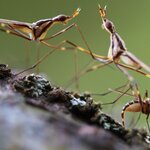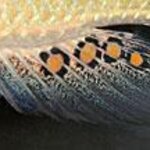Evolution

It seems counter-intuitive that in order to survive best as a species, not everything can live forever, but some cells in our bodies are fated to die, and a Mission Impossible-style auto-destruct program insures they do.
This elaborate cell death program, known as apoptosis, got a little more insight with a study on the evolution of caspase-8, a key cell death initiator molecule that was first identified in humans. By performing the most extensive evolutionary analysis of the Casp8 protein to date,
Sakamaki et. al.,
write in Molecular Biology and Evolution
that Casp8 activity arose…
An interesting experiment published in Science placed baker's yeast (
Saccharomyces cerevisiae) in separate identical bioworlds. Then, at the same time, historical contingency events would happen, just like they have on earth - and only the fittest survived.
Evolution tells us that there are things besides natural selection going on - there are mutations and genetic drift. If we boiled up some primordial soup today, a few billion years from now the planet would be a lot different due to that randomness.
Or not.
A few years ago, a game called Spore came out. It was supposed to be a love ode to…

Parasitic bacteria were the first cousins of mitochondria, the energy factories in our cells – and first acted as energy parasites in those cells before becoming beneficial, according to a University of Virginia study that used next-generation DNA sequencing technologies to decode the genomes of 18 bacteria that are close relatives of mitochondria.
The new paper in PLOS One is an alternative theory to two current hypotheses of how simple bacterial cells were swallowed up by host cells and ultimately became mitochondria, the "powerhouse" organelles within virtually all eukaryotic cells –…

What's not red and about the size of your thumb?
Tomatoes, before ancient scientists set out to make them patabale. This genomic history of tomato breeding, based on sequencing of 360 varieties of the tomato plant, has vaulted beyond the first tomato genome sequence completed just two years ago. It will lend insight into science for people who believe genetic modification only began happening during the Clinton administration.
Analysis of the genome sequences of these 360 varieties and wild strains shows which regions of the genome were under selection during domestication and breeding…

A female neriid fly (right) laying eggs, while her mate fights off a rival male. Angela Crean and Russell Bonduriansky. Credit: Author provided
By Angela Crean and Russell Bonduriansky
Thanks to the father of modern genetics, Gregor Mendel, and his experiments cross-breading peas, the textbooks tell us that we know how inheritance works: we get 50% of our genes from our mums and 50% of our genes from our dads.
But is something else at play in determining how the offspring may look? That’s what we’ve discovered in certain flies which may extend to other species.
Our phenotype (the way we…

The evolution of new traits with novel functions has long been studied by evolutionary biology and a new study of the color markings of cichlid fish has shed some new light on it.
Swiss scientists writing in Nature Communications show what triggered these evolutionary innovations, namely: a mobile genetic element in the regulatory region of a color gene.
Biological evolution is in general based on the progressive adaption of traits through natural or sexual selection. However, ever so often, complex traits with completely new functions arise such as insect wings, feathers or the…

In the past, researchers have primarily used the genetic history of mothers to understand evolution in animals, but a new study has investigated ancestry across the red fox genome, including the Y chromosome (paternal line) and found some surprises about the origins, journey and evolution of the red fox, the world's most widely distributed land carnivore.
Conventional thinking based on maternal genetics suggested that red foxes of Eurasia and North America composed a single interconnected population across the Bering land bridge between Asia and Alaska.
In contrast, this new research…

Sparkling Violetear.Image courtesy of Paul Martin
By Katharine Gammon, Inside Science
(Inside Science) – Most of the time, for an individual animal, the bigger you are, the more likely you are to succeed. But sometimes, the little guy prevails – and scientists are just starting to understand how and when this happens.
“While there has been research on body size and aggressive conflict, no one had looked at why small species can prevail,” said Paul Martin, a biologist at Queen’s University in Kingston, Ontario.
Martin chose three aggressive kinds of interactions to focus on: vultures gathering…

I have just downloaded a paper featuring some research from the University of Durham and our own School of Biological Sciences here at Reading:
Rapid Evolution of the Cerebellum in Humans and Other Great Apes
(aside: “I don’t think humans are that great”, says Charlie the Chimp.)
Rearranging the abstract, we read:
Humans’ unique cognitive abilities are usually attributed to a greatly expanded neocortex, which has been described as “the crowning achievement of evolution and the biological substrate of human mental prowess”. The…

Heart racing and fists shaking, I stood ready to fight. I was moments
away from sparring with the top student in my karate class in Japan: a
fast, coordinated monster who had defeated all challengers. But
nanoseconds before the fight began, something shifted. Nervous
anticipation disappeared and I snapped into total focus. The room, the
other students, and everything else faded into irrelevance, leaving my
awareness filled only with my opponent in his white gi.
When
the coach shouted, “Go!,” my body shot through the air like a lightning
bolt, my fist connecting to my opponent’s ribs.…